The first requirement for successful b-tagging is the efficient, clean and precise reconstruction of the charged particle trajectories in the jet. For very high pT jets (200 GeV - 1 TeV) this task is highly non-trivial - even with the state-of-the-art tracking algorithms - for a number of reasons. As the jet energy increases,the track multiplicity (from fragmentation) increases. Moreover, the jets become more and more collimated. The combination of these two effects lead to a very high density of tracks in the jet core. This effect is present both in b-jets and in light flavour jets. In b-jets, the flight distance of the B- and D-hadrons may become quite large for the highest energy jets. If the decay takes place close to the vertex detector layer, hits from nearby tracks may not be resolved individually. For a signficant fraction of tracks, the decays even take place beyond the 1st (and even second and third) detector layer.
The combination of effects described above renders these jets quite a challenge to the pattern recognition stage of the track reconstruction algorithms. In what follows, the efficiency with which tracks are reconstructed is evaluated.
Tools In recent versions of the ATLAS AOD (I am working with ATHENA versions 12.0.3, 12.0.6, 13.0.10 and 13.0.20, but results are quite similar for all versions) the association between reconstructed tracks and Monte Carlo truth particles is stored in a handy map called TrackParticleTruthCollection (thanks to Andrei Gaponenko). The efficiencies presented below are obtained as follows:the TrackParticleTruthCollection is inverted to allow for lookup with Monte Carlo truth particles.
Samples
A sample of low and moderate momentum jets is used as a reference. For convenience, and to allow comparison with previous resutls, the usual WH120 and WH400 samples of the b-tagging group are used. The Higgs boson is decayed into a bb, cc or uu pair. The b-jet energy thus ranges from 50 to 200 GeV. Official CSC production samples.
To study the performance in very high pT jets a dedicated sample is produced. A heavy partner of the Z boson (ZH) with a mass of 2000 GeV is decayed into bb, cc and uu. Thus, the jet energy range is extended to 1 TeV. Private production of the Valencia group (Lluis March) using production tools. The sample has been validated against an official sample of limited statistics.
Efficiency definitionThe inverted map is queried with all charged particles that have no daughters (these particles form the end of a decay chain, i.e. they are stable and do not suffer interactions with the detector material). The particles are required to originate in a well-defined vertex (for example, the interaction point). Thus, only particles that traverse the whole tracking volume are selected. We furthermore limit the study to charged pions with a transverse momentum of at least 1 GeV. The MC truth particle is considered efficiently reconstructed if a track is associated to the particle with a probability of at least 80 %.
Two classes of particles are distinguished:
- Prompt tracks: the origin vertex of the MC truth particle is required to be within 10 mm of the interaction point (considering this class of particles, the efficiency definition is comparable to that usually applied by the b-tagging group).
- B-/D-decay tracks: the origin vertex of the MC truth particle is required to be within 10 mm of B-/D-decay vertex (this new class of particles provides a clean sample to study the effect of displaced production vertices).
Legend:
- Prompt tracks: square markers
- B-/D-decay tracks: round markers
- IPatRec: open red markers
- New Tracking: filled green markers
Results: reference sample
To establish the reference performance we determine the track reconstruction efficiency for a sample of low and moderate pT sample (a mixture of the usual WH samples with Higgs masses of 120 and 400 GeV used to benchmark the b-tagging performance)
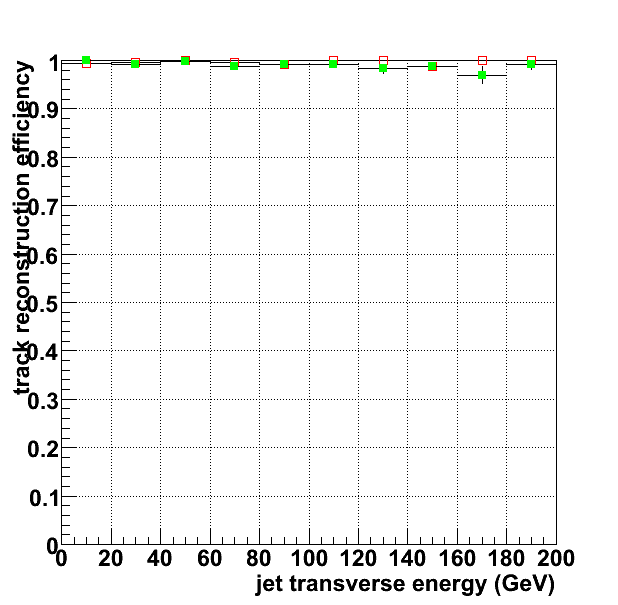
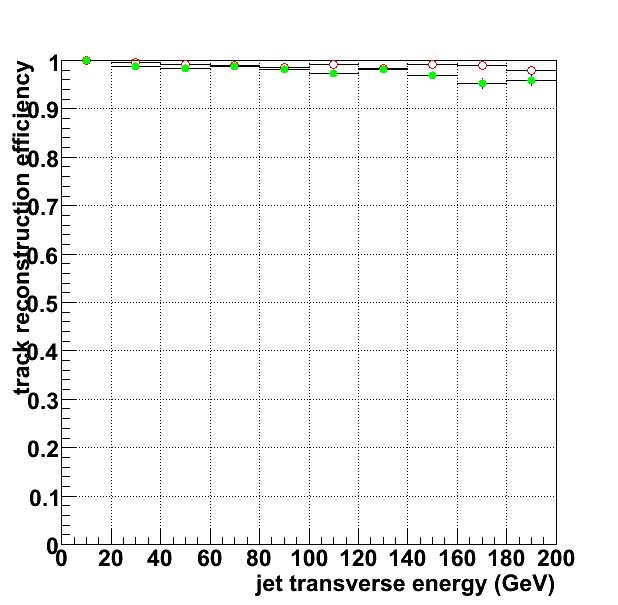
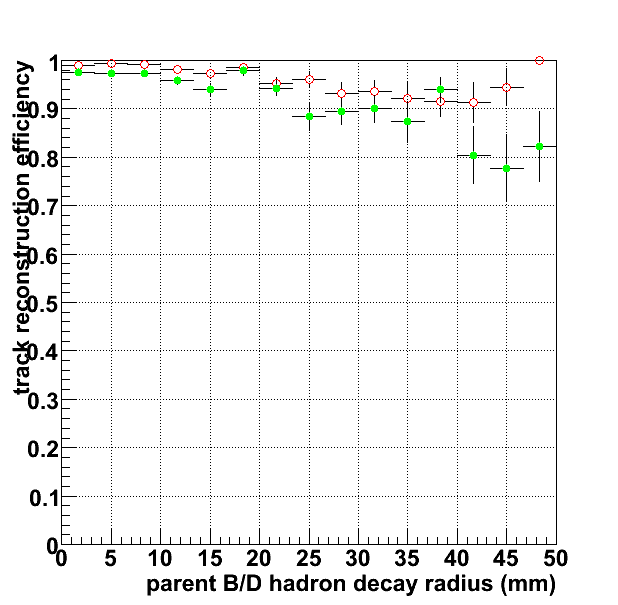
Reference (WH120, WH400) sample: Track reconstruction efficiency versus jet transverse momentum for prompt tracks (leftmost figure) and decay products of B/D hadrons (central figure). The tracking efficiency is found to be quite robust in this jet energy range. For non-prompt tracks, a slight degradation of the efficiency is observed for the highest energies.
Reference (WH120, WH400) sample: Track reconstruction efficiency versus decay radius of the parent B/D hadron (rightmost figure). A closer look at the vertices with large displacement (large meaning up to 50 mm in this case) show a signficaand decay products of B/D hadrons - although not dramatic - degradation of the efficiency for both algorithms.
In the reference sample a moderate degradation of the tracking efficiency is observed in the jet core of the jets with highest pT (200 GeV). The degradation is most pronounced for tracks originating in displaced B/D-decay vertices.
Results: high pT (ZH2000) sample



High pT (ZH2000) sample: Track reconstruction efficiency versus jet transverse momentum for prompt tracks (leftmost figure) and decay products of B/D hadrons (central figure). Even for a jet transverse energy of 1 TeV (!) the track reconstruction efficiency for prompt tracks is approximately 90 %. For non-prompt tracks, however, the degradation for the highest jet energies is much more substantial: at 1 TeV the track efficiency is only 50-60 %.
High pT (ZH2000) sample: Track reconstruction efficiency versus decay radius of the parent B/D hadron (rightmost figure). The effect of the displaced parent vertex of B-/D-decay products is quite dramatic. The efficiency starts to fall even for moderately displaced vertices, and reaches ~20 % for the most displaced tracks (at 15 cm).
Some care is required when interpreting these results. There is a strong correlation of the jet energy and the decay vertex radius (through the b-fragmentation function and the Lorentz boost &gamma). Moreover, the decay products from B/D hadrons tend to be in the dense jet core, while prompt fragmentation tracks are distributed more uniformly over the jet cone. Therefore, the underlying cause of the degraded tracking efficiency cannot easily be distinguished from mere collateral effects (if there is a single cause).
The high pT jet samples used to determine the efficiencies are publicly available on IFIC's CASTOR system:
/castorgrid.ific.uv.es/castor/ific.uv.es/grid/atlas/datafiles/march/CSC_btagging/13.0.10.1-digit
/castorgrid.ific.uv.es/castor/ific.uv.es/grid/atlas/datafiles/march/CSC_btagging/13.0.10.1-recon/ESD
/castorgrid.ific.uv.es/castor/ific.uv.es/grid/atlas/datafiles/march/CSC_btagging/13.0.10.1-recon/AOD
To copy these files use globus-url-copy, i.e.:
globus-url-copy -verbose gsiftp://castorgrid.ific.uv.es/castor/ific.uv.es/grid/atlas/datafiles/march/CSC_btagging/12.0.6.1-recon/AOD/bb/trig1_misal1_mc12.006602.Pythia_ZHbb2000.recon.AOD.v12000601._00080.pool.root file:///tmp/kk.pool.root
For people working on lxplus I mirror the AOD sample on my CASTOR account at CERN: /castor/cern.ch/user/v/vos/CSC/13/.
A production using 13.0.20 is ongoing. Samples will be made available as soon as possible.
There are several things worth taking a closer look at:
Shared hits: the combination of displaced decay vertex (small distance to the vertex detector layers) and high track density leads to confusion (merging hits) in the pixel layers. See the detailed discussion further on...
Seed generation: for decay vertices beyond the first pixel layer the seed-finding efficiency of the pixel-based seeding is likely to suffer. This would need confirmation. The efficiency of back-tracking from the TRT is a question mark in this high density environment. What about SCT seeding (or combined pixel-SCT)?
Monte Carlo: the B-decay is taken care of by the generator, even in case the flight distance is so large that the B-hadron traverses detector material. Therefore, the hit of a charged B-hadron in the first pixel layer is missing. Discussions with Adele Rimoldi, Andrea Dell'Acqua (from the simulations group) and Maria Smizanska (B-physics group) have yielded a wealth of background information on this long-standing problem.
Z-scan: the seeding in 12.0.6 applied a z-scan. This has been removed in the 13.0.X series. The performance with both versions is identical (within errors). Therefore, this can be discarded as a possible cause of problems in seeding tracks originating in displaced vertices.
Cone size
High pT jets are collimated in a narrow cone. Therefore, the default value used as track-to-jet association criterion in the b-tagging algorithms ( &Delta R < 0.4 ) is not valid in this case. In the following figure the &Delta R distance between tracks and the jet axis is shown as a function of jet transverse energy. The leftmost figure corresponds to fragmentation tracks, the rightmost figure to tracks proceeding from the B or D-hadron decay.
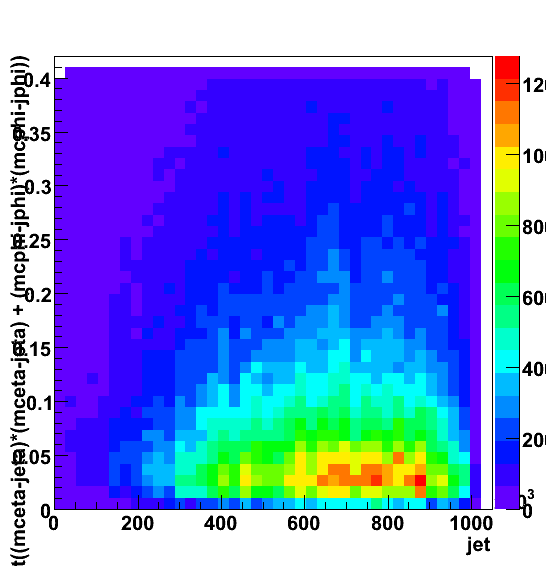

Pixel Clustering
The merging of hits in the dense environment is particularly relevant in the innermost detector layers. Therefore, the pixel clustering algorithm may have a significant impact on the tracking performance.
In the following figures the distribution - in XY and RZ views - of pixel clusters in 250 ZH &rarrow bb events is shown.
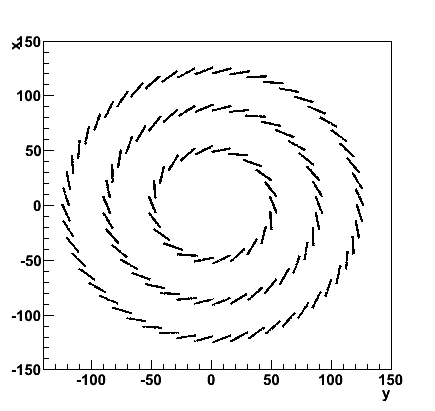
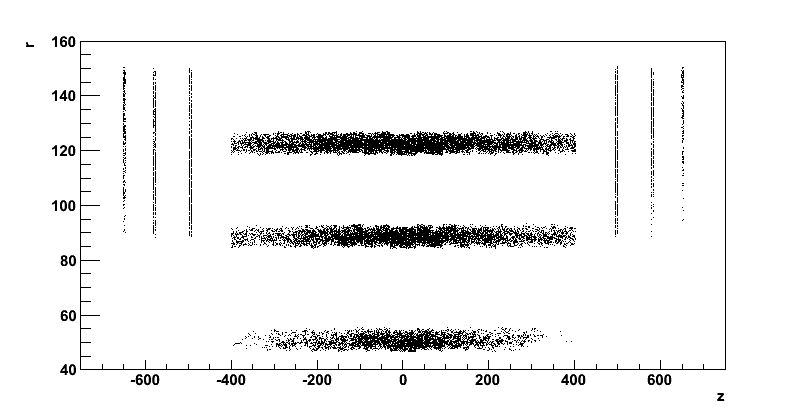
The dominant effect on pixel cluster size comes from the incidence angle of the track. The cluster size is minimal for perpendicular incidence and increases as the projection on the read-out plane becomes larger.
Low momentum tracks are curved in the magnetic field. Their incidence angle thus becomes significantly different from perpendicular. Therefore, these tracks yield broader clusters in the R &phi view. In very dense jets the merging of pixel clusters starts to play a role. In the leftmost figure below, the fraction of pixel with a size in the R &phi direction greater than 1 is shown. The three points correspond to the three pixel barrel layers. Two curves are shown, the open red markers correspond to the core of high pT b-jets (&Delta R < 0.15). The black markers represent the much less dense outer region of the jet. On average 30-40 % of clusters contain more than one pixel in the R &phi direction. The effect of the increased density in the jet core is an increase of this fraction by nearly 10 %.
In the next three figures the fraction of clusters with a width greater than 1 in the Rz view is shown. Each figure correponds to a barrel detector layer. As expected, the cluster width increases strongly with pseudo-rapidity. The fraction of multi-pixel cluster increases from 30-40 % in the central tracker to 60-70 % for tracks towards the end of the barrels. The effect of the dense jet core is quite strong: for pseudo-rapidities between 1 and 2 the fraction of multi-pixel clusters increases very strongly in the jet core.
Thus, the effect of merged pixel clusters in dense jet cores is most clearly observed in the Rz view, while a smaller increase is present in the R &phi view.
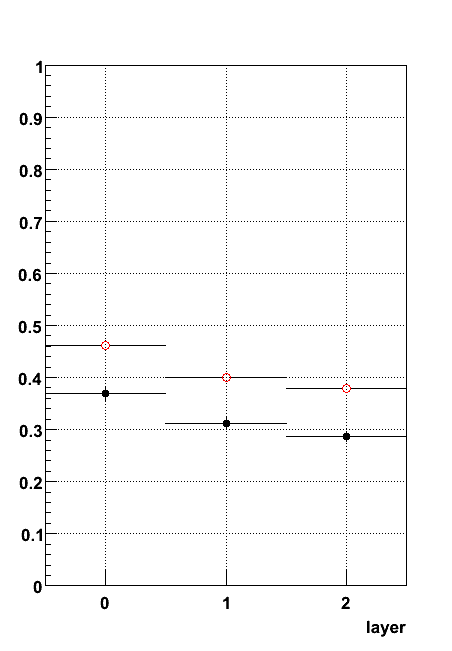
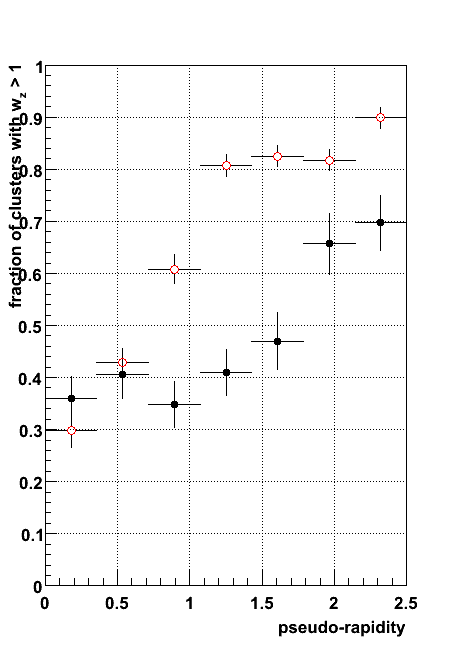

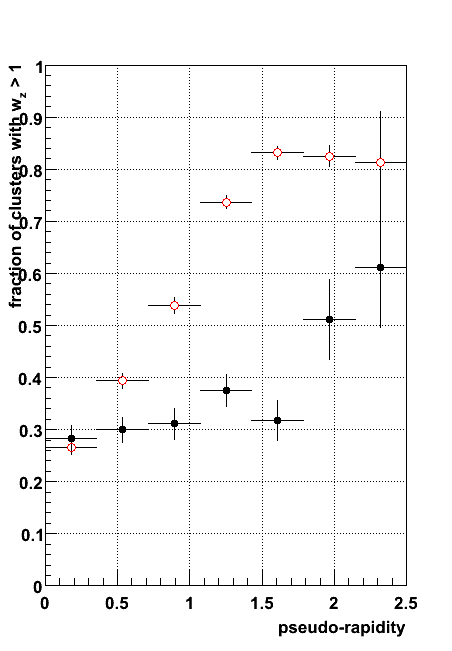
Shared hits
The high pT jets form a very dense environment. There is a non-negligible probability that several hits merge into a single indistinguishable cluster.
The effect of a merged hit is an increased hit position error. If the shared hit is in the B-layer this leads to a deterioration of the impact parameter. The figure below shows the d0 error estimate as a function of transverse momentum for two sets of tracks: the black markers correspond to tracks with an unambiguous hit in the B-layer, the red markers correspond to tracks where the B-layer hit is shared between more than one track. Clearly, the estimated uncertainty on the transverse impact parameter is significantly larger for tracks where the innermost measured is shared.
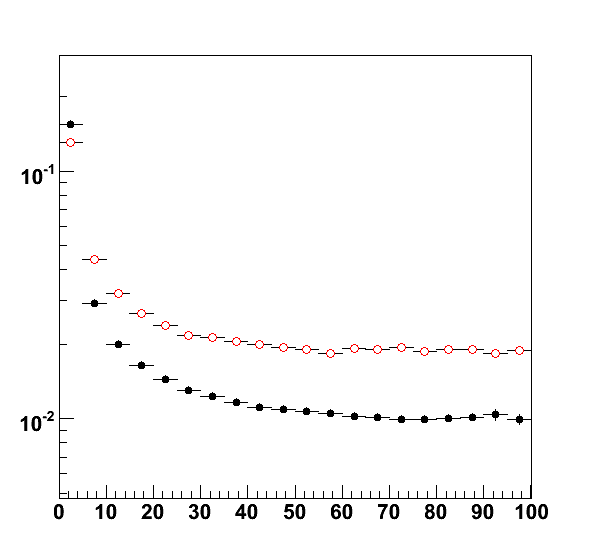
The validity of the error estimate is typically cross-checked by constructing the pull distribution. For tracks from the primary vertex the d0 pull should be a Gaussian distribution, centered at 0 and with width=1. In the figure below, the pull distribution is compared for tracks that do (upper histogram) or do not (lower histogram) share the B-layer hit. Both distributions show the Gaussian shape and correct width. The tails are much more pronounced in the case of tracks that share the innermost measurement.
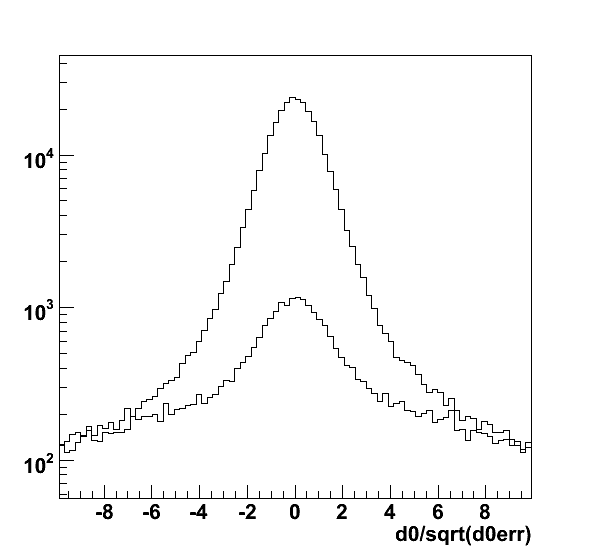
The probability that hits are shared is highest in the dense jet core, as becomes clear in the figure below that shows the fraction of tracks with a shared b-layer hit as a function of distance to the jet core. The analysis is limited to correctly reconstructed tracks (i.e. matched to a MC truth particle). The two sets of markers correspond to two different tracking algorithms: green, closed markers to New Tracking, red, open markers to IPatRec. Both algorithms show a similar dependence: in the dense jet core the shared hit probability increase very signficantly. The number of shared hits is, however, quite different. This is due to the AmbiguityResolver of the New Tracking algorithm, that tries to assign shared hits unambiguously to one track or another.
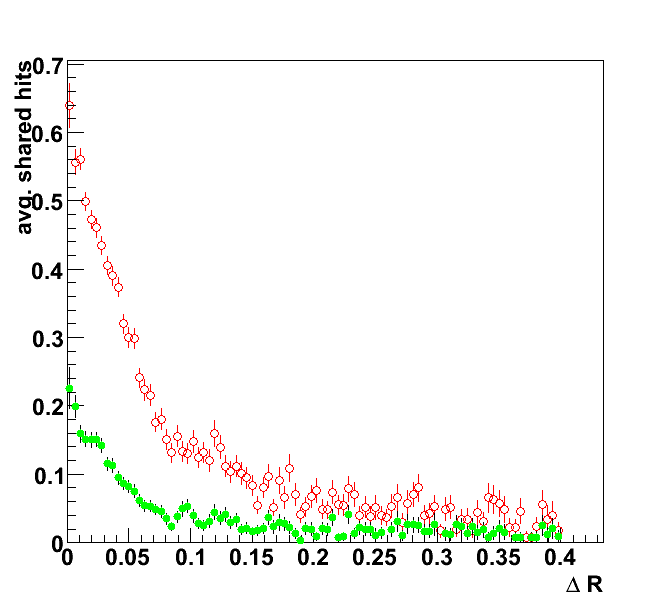
A closer look at the shared hit probabilities yields the figure below: the three different markers indicate the average number of shared hits in the B-layer (crosses), in the pixel detector (circles) and in the whole silicon tracker (red markers). The leftmost figure corresponds to tracks from B/D-decay, the rightmost figure to the remaining tracks. The upper two figures were obtained using the New Tracking algorithm, the low two using IPatRec.
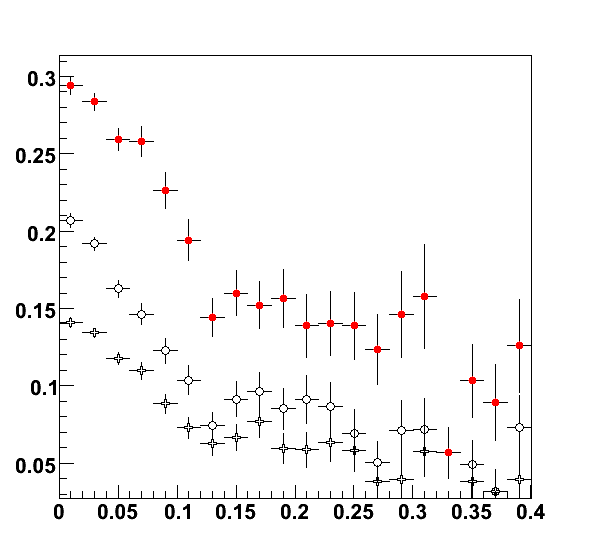

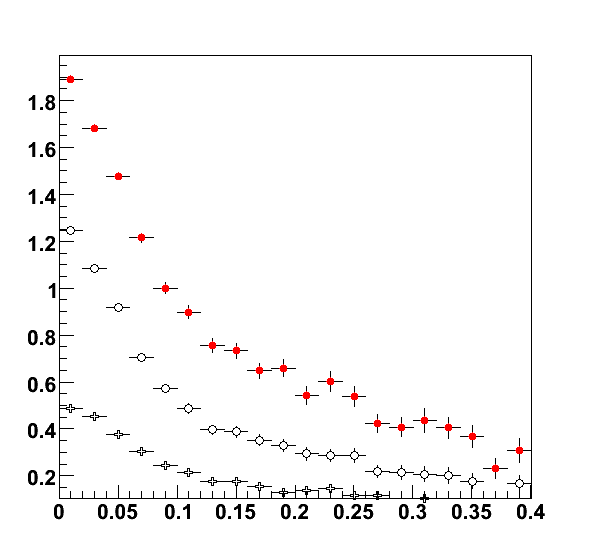
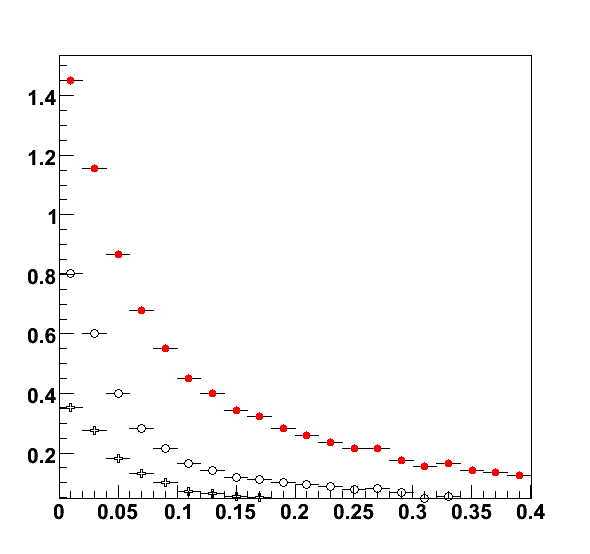
Clearly, tracks from B-decay have a higher probability to share hits in the pixel detector. In the figures below, the probability that a track from B/D-decayt shares a hit in the B-layer is plotted versus the decay radius of the parent particle. The leftmost figure corresponds to New Tracking, the rightmost figure to IPatRec. Clearly, hits from tracks originating in B/D-hadrons decaying at a small distance from the B-layer cannot be distinguished.
In the figures below the average number of shared hits per track is shown for efficiently reconstructed particles that originate in B/D decay. The three marker types correspond to different sub-sets of detector layers: the B-layer (crosses), the pixel detector, including the B-layer (round markers) and the whole silicon tracker, including the pixel detector (red markers). The dependence on the radius of the B/D decay vertex is most clearly visible in the probability to share hits in the B-layer. Clearly, if a highly boosted B-hadron decays at a small distance from the pixel layer, the pixels are no longer small compared to the distance between hits and hits inevitably merge.
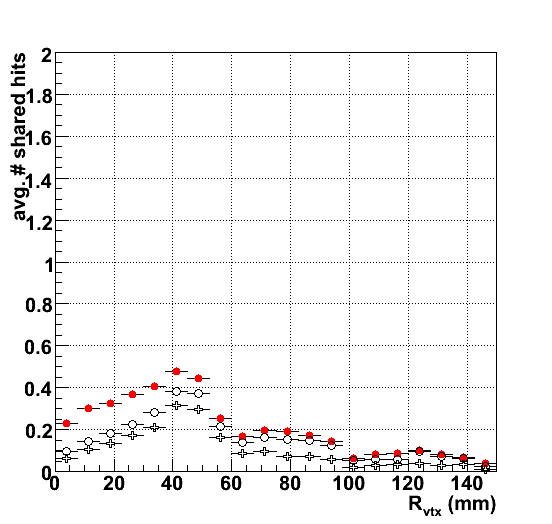

An interesting observation is the quite different result for the two track reconstruction algorithms. While qualitatively the behaviour is similar, the fraction of shared hits in New Tracking is quite significantly lower than that of IPatRec. The "working explanation" is that this is due to the AmbiguitySolver in New Tracking that intends to assign shared hits to one of the tracks (the "best" track). It would be interesting to test this hypothesis by varying the parameters of the AmbiguityResolver (or even switch it off completely).
In either case, shared hits cannot simply be ignored for very high pT jets. A traditional quality cut employed in most b-tagging algorithm that requires that there none of the hits on the track is shared with another track leads to an unacceptably track survival probability (and consequently to a severe degradation of the b-tagging performance).
On the other hand, shared hits, especially in the B-layer, present a threat. The incidence of badly measured impact parameters is much higher than in tracks that have an unambiguous assignment of the B-layer hit. In the following, six exclusive track categories are defined as follows:
- perfect tracks, with a B-layer hit, where none of the hits is shared
- tracks with a B-layer hit with shared hits in PIX or SCT, but none in the B-layer
- tracks with a shared hit in the B-layer, but none in the remaining layers
- tracks with a shared hit in the B-layer and PIX or SCT
- tracks with no B-layer hit, and no shared hits
- tracks with no B-layer hit and shared hits
The relative abundance of the six categories (histogram with grey fill colour) is obtained by simply counting the number of tracks in a given sample and normalising to the total number of tracks. The usefulness of tracks in each category (red markers) is evaluated by counting the number of tracks with a transverse impact parameter significance greater than 3. For b-jets, a large fraction of tracks with significant impact parameter is of course beneficial, for light jets the number should be as small as possible.
Below, the track category analysis is applied to IPatRec track in jets in the highest pT bin: 800 GeV < E T < 1 TeV. The leftmost figure corresponds to a light-jet sample and the rightmost figure to tracks from B/D decay. The analysis includes all tracks that pass a pre-selection that requires an impact parameter significance of less than 30 and at least 9 silicon hits.
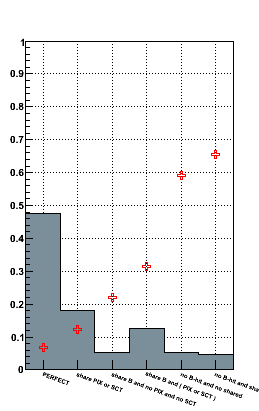
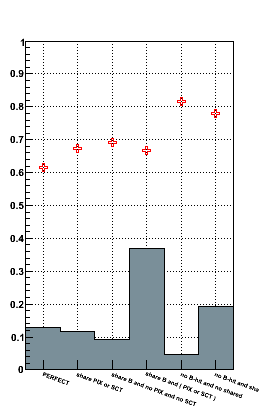
Clearly, tracks in the first two categories provide a very clean sample: the probability that a track in a light jet fakes a large impact parameter significance is approximately 10 %, while tracks from B/D decay have a 60 % probability. In the light jet sample (with prompt tracks) these categories are also the most abundant: together they make up nearly 60 % of the tracks. For the tracks from B/D decay these categories are much less populated: most tracks appear in the category with a shared hit in the B-layer AND in at least one other layer and in the last category where no B-layer hit is found AND at least one of the hits is shared.
The figures below were obtained by repeating the analysis for all tracks with a pT of greater than 10 GeV.










Vertexing in high pT jets
Naturally, vertex reconstruction only stands a change of success if the input - the tracks - is of high quality. In the following, the effect of the failing track reconstruction clearly works through in the vertexing performance.
The vertex reconstruction efficiency (BTagVertSec vertexing algorithm optimized for SV1 b-tagging). For b-jets (red) the efficiency clearly drops with increasing jet transverse energy. For u-jets the efficiency (well, the number of fake vertices) grows with energy. Curiously, the probability to reconstruct a secondary vertex in b- and u-jets is nearly the same for the highest energy bins.
vertex_eff.eps
Distributions for several observables related to vertices reconstructed in high pT jets. All distributions are for all reconstructed vertices in u- (red) and b-jets (black). The distributions are given separately for three jet transverse energy intervals: 200-500 GeV, 500-800 GeV, 800-1200 GeV. All distributions are normalized to 1.
The variables are
- NTRK: number of tracks in the vertex
- N2T: number of two-track vertices
- MASS: the invariant mass of the reconstructed vertex
- efrc: fraction of jet energy carried by vertex tracks
- radius: the radius of the reconstructed vertex
Result for the recent CSC samples (reconstructed with ATHENA 12.0.6):
vtx_ntrk_200_500.eps
vtx_ntrk_500_800.eps
vtx_ntrk_800_1200.eps
vtx_n2t_200_500.eps
vtx_n2t_500_800.eps
vtx_n2t_800_1200.eps
vtx_mass_200_500.eps
vtx_mass_500_800.eps
vtx_mass_800_1200.eps
vtx_efrc_200_500.eps
vtx_efrc_500_800.eps
vtx_efrc_800_1200.eps
vtx_radius_200_500.eps
vtx_radius_500_800.eps
vtx_radius_800_1200.eps
Result for old "Rome" samples (reconstructed with ATHENA 11.0.1):
vtx_ntrk_200_500.eps
vtx_ntrk_500_800.eps
vtx_ntrk_800_1200.eps
vtx_n2t_200_500.eps
vtx_n2t_500_800.eps
vtx_n2t_800_1200.eps
vtx_mass_200_500.eps
vtx_mass_500_800.eps
vtx_mass_800_1200.eps
vtx_efrc_200_500.eps
vtx_efrc_500_800.eps
vtx_efrc_800_1200.eps
vtx_radius_200_500.eps
vtx_radius_500_800.eps
vtx_radius_800_1200.eps
References
Some documents on the same subject:
Presentation in the Marseille b-tagging workshop (May 2007)
Presentation in the Inner Detector software meeting